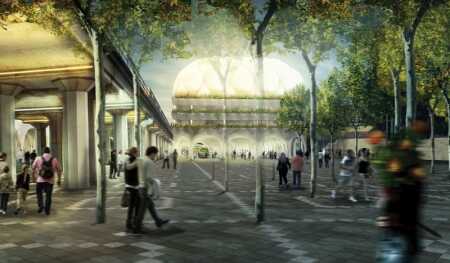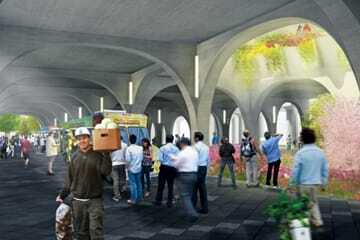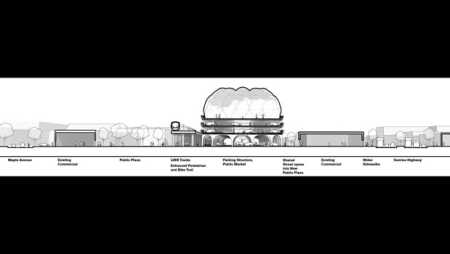
The flexible parking structure is located next to a colonnade under the adjacent Long Island Rail Road (LIRR) commuter rail line, which would be turned into a pedestrian spine through the heart of Rockville Centre’s downtown. The structure has 20-foot-tall (6 m) ceilings at grade to act as a covered plaza during off-peak parking hours in the evening and on weekends, when public markets and festivals can also spill out onto a contiguous open plaza. (Utile Inc.)
A design challenge inspires a proposal for flexible parking structures that can house a range of uses—and spur mixed-use, transit-oriented development.
For urban planners who consider the automobile the major cause of the deterioration of cities, loss of community spaces, elimination of mixed uses, and decimation of urban street life, it may seem a contradiction to propose construction of parking structures as the cure. Yet that is precisely the intent and result of a proposal submitted in a design challenge sponsored by a nonprofit entity, supported by a regional foundation, and entered by leading architects and urban planners.
In suburban downtowns, where sufficient parking is still critical to operational viability, land prices and parking rates typically have not risen to levels that support the cost of structured parking. As a result, vast quantities of land are committed to surface parking in patterns that work against adequate numbers and concentration of the shops, restaurants, theaters, and cafés that draw enough patrons to activate those downtowns. Redevelopment potential could be substantial. For example, more than 4,000 acres (1,600 ha) in and around Long Island’s downtowns are dedicated to parking.
In addition to being expensive, structured parking facilities are generally single-purpose, stand-alone structures that sit empty during evenings and weekends and are filled only sporadically. In suburban downtowns near commuter rail lines or new light-rail extensions, weekday demand for park-and-ride facilities can overwhelm the parking supply, displacing the shorter-term parking needed to revitalize those downtowns. Yet most such expensive parking facilities lie fallow during evenings and weekends.
Facing this chicken-and-egg conundrum, the Long Island Index, a nonprofit organization funded by the Rauch Foundation—a Garden City, Long Island, family foundation intended to spark and sustain regional systemic change—organized a design challenge. The goal was to demonstrate how a suburban downtown setting can be transformed by such structures—when they are exceptionally well designed and feature innovative architectural, technical, operational, and financing strategies as part of a broader approach to managing downtown parking and mobility.
In response, architects and urban planners Tim Love, founding principal, and designer Elizabeth Christoforetti at Utile, a Boston-based architecture and urban design firm, developed a solution, dubbed “Civic Arches,” based on two principles.

Utile Design proposed 20-foot-high (6 m) ceilings on the floor at grade so that when the structure is mostly vacant, it could be used for a variety of civic uses, such as public markets, food carts, and festivals. In future years, at-grade parking might be limited and the perimeter bays used for more permanent shops and restaurants, with adequate parking provided on upper floors.
First, parking structures need to be used for longer periods of the day and for different purposes, both public and private. With single-purpose parking—designated for support of office, retail, hotel, housing, or entertainment facilities alone—patterns of use are highly variable depending on the time of day, the day of the week, or the season. Such inefficiencies drive up the cost of building and maintaining parking structures.
Second, parking structures need to be designed as flexible structures that can accommodate transitions from parking alone to a variety of other uses as parking ratios decline with further mixed-use development and increased use of shared parking facilities and transit. Future functions for these properties should include civic, office, retail, hotel, housing, and entertainment uses. Cities evolve over time, and the functions of structures can change if they are designed for flexibility.
“The early 20th-century loft building was our model for how to design a flexible building that could be repurposed over time,” Love said of earlier prototypes that influenced Utile’s thinking. “Examples include the cast-iron loft buildings in Soho and the brick warehouses that the Boston Wharf Company built in the Fort Point District in Boston in the early 20th century. In most American cities, this type of building has been especially adaptable to residential and office conversion because of the simple column grid, workable floorplate dimensions, the structural capacity, and large windows. We think that architects should focus more on future-use buildings rather than one-off structures that are customized for a very specific program. Unfortunately, architects are not typically trained to think this way.”
Parking structures need to be designed to accommodate transitions, from parking alone to other uses as parking ratios decline with further mixed-use development, shared parking, and increased transit.
Love and Christoforetti searched for the optimal module that could be adapted to all potential future uses for the universal utilitarian structures. That module proved to be a 30-by-30-foot (9 by 9 m) bay. Standard parking bays for perpendicular parking are 60 feet (18 m) wide, allowing for 18-foot-deep (5.5 m) parking spaces flanking a 24-foot (7 m), two-way drive aisle. In their prototype design, to shift the columns of the 30-foot (9 m) bays out of the center of the drive aisle, 15-foot-wide (5 m) bays ring the perimeter of the structure.
Says Love, “A 30-foot bay is the ideal dimension for a structure that begins as a parking garage and can then be repurposed for office/flex space or housing in the future. An efficient parking configuration that uses a 30-foot bay requires the system to start with a 15-foot bay so that the first 30-foot bay is centered over the drive aisle. This is how, more generally, the two-dimensional systems sync up. Therefore, lateral parking bay dimensions for a 120-foot-wide [37 m] double-bay garage are 18-24-18 and 18-24-18 feet [6-7-6 m] while the corresponding grid is 15-30-30-30-15 feet [5-9-9-9-5 m].”
The proportions and dimensions of these flexible structures can also accommodate a variety of future uses. The three-bay-wide prototype structure Love and Christoforetti designed, for example, can accommodate a future double-loaded-corridor (units flanking a center hallway) residential building around a center courtyard, which would be formed by removing the center 60-foot-wide (18.3 m) inclined driving ramps. And comfortable hotel rooms could easily fit within a 15-by-30-foot (5 by 9 m) bay dimension. The narrower two-bay prototype also has suitable dimensions for a future 120-foot-wide (37 m) office building.
Different-sized retail shops and restaurants could fit within the 15-, 30-, 45-, and 60-foot (4.6, 9.1, 13.7, and 18.3 m) depths. Recreational uses would fit on the rooftops of the two- and three-bay structures. Tennis courts at 36 by 78 feet (11 by 24 m) can fit side-to-side with adequate access space on top of the two-bay structure. In fact, for the parking structure proposed for the Lot 3 surface parking lot in the village of Rockville Centre on Long Island, Utile—at the request of local officials and as part of the design challenge—proposed five tennis courts, covered by a pneumatic bubble that would allow use of the area for indoor events and glow at night as a visual attraction to passersby on the adjacent Long Island Rail Road (LIRR) commuter rail line. The team even sited a 180-by-300-foot (55 by 91 m) soccer field on the rooftop of a three-bay structure to demonstrate its recreational flexibility.
Traditional parking structures have minimal ceiling heights of seven to eight feet (2.1 to 2.4 m) that preclude conversion to other commercial or civic uses. Utile proposed 20-foot (6 m) ceilings on the floor at grade so that when the structure is mostly vacant on evenings and weekends, it could be used for civic purposes such as a public market, a staging area for food carts, or festivals. In future years, the at-grade parking could be limited and the perimeter bays used for more permanent shops and restaurants, with adequate parking on upper floors, which Utile designed with 11-foot (3.4 m) ceiling heights to permit conversion to other uses.
The fact that Rockville Centre’s sites mostly flank the LIRR also influenced Utile’s design of the structures. Stout octagonal columns with prominent octagonal capitals form a colonnade that elevates the LIRR tracks. Utile would recapture that space as a covered pedestrian spine through Rockville Centre’s downtown. The new flexible parking structures, with their high-bay, open first floors, would flank the colonnade and extend the public realm into covered and open plazas.
For centuries, the arch and vault have been used to create civic spaces. Utile looked to earlier arched forms for bridges and viaducts, such as those under the nearby Gowanus Expressway and Queensboro Bridge, and to the conversion of a defunct suburban railway into the Viaduc des Artes in Paris. The more gracious heights of the structures do not preclude utilitarian methods to construct them, Utile contends: it proposes use of efficient tilt-up concrete construction for the arches. Running perpendicularly, such arches would buttress each other—much like in a Toyo Ito–designed library at Tama Art University in Tokyo—and create a rhythm of arched vaults that could give a monumental civic character to a suburban town lacking a civic venue. Hence the name Civic Arches for the concept.
The strong arched concept permits concrete floors above that are poured in place. They would be more flexible for future conversions than the more common, thinner, post-tensioned concrete floors. The tensioned cables embedded in such floors cannot be severed without compromising structural integrity, limiting the placement of plumbing, electrical and mechanical lines, and chases.
How is it possible that building new parking structures—adding parking spaces to suburban downtowns divided by a plethora of surface parking lots—can be economical despite the considerable expense? There are several reasons:
- Shared parking. Scattered surface parking lots, just like structured parking under a single office, residential, or hotel building, serve mostly a single use and are often vacant. They cannot support mixed uses. But centrally located parking structures of adequate size can offer a sufficient density of parking spaces to support an equivalent density of mixed uses. Until most goods and services are conveniently supplied within walking distance or served by high-frequency transit, residents will own and use cars that need to be parked. In fact, the less that car-owning residents of the mixed-use development use their cars, the more they will need spaces in which to park them.
So a higher density of uses requires a higher density of parking spaces—precisely the reverse of conventional wisdom. The way to economize on their construction, proponents reason, is to maximize their occupancy. And the only way to do that is to mix the uses that such spaces support, because then the peak periods for one use complement those of another use with different peak periods. Furthermore, because structured parking can cost more than $40,000 per space, and developers generally do not make money on building or selling the parking spaces but rather on the uses they support, careful developers want to build the fewest spaces possible and maximize their use through shared parking.
The Rockville Centre plan benefits because many of the uses in and near the project—such as recreation, theaters, and restaurants and cafés—have peak parking demands at times when LIRR commuter spaces are empty. Consultants anticipate such new mixed uses could create hundreds of new permanent jobs.
Redevelopment. The more than 4,000 acres (1,600 ha) of surface parking in and around Long Island’s downtowns represent large land banks more than one quarter the size of Manhattan, 35 minutes away from Rockville Centre on the LIRR. In fact, consultants note, when Morristown, New Jersey, which is twice the distance from Manhattan by train, constructed a $10 million, 700-space downtown parking garage in 2000, it catalyzed more than $60 million in new residential and commercial development in the immediate vicinity over the following five years. A second, 800-car downtown garage completed in 2008 at a cost of about $16 million supported a new round of residential and commercial redevelopment totaling $125 million.
Tax revenue. Gerard Giosa, a parking consultant and president of Old Bethpage, New York–based Level G Associates, estimates that based on projected development supported by flexible parking solutions, Rockville Centre will generate $2 million of additional revenue annually from property and sales tax. In addition to forecasting property tax revenue from new housing, hotels, offices, and entertainment, Giosa says those attracted to suburban downtown living would spend about 30 percent of their discretionary income on shopping, eating, and entertainment.
Despite the long-term macroeconomic factors favoring development of such parking structures, financing of their construction can be a challenge. Giosa cites the Morristown Parking Authority as an example of a solution. The quasi-public agency, created to finance, develop, maintain, and operate the municipal parking system, developed the Morristown garages with 30-year tax-exempt parking revenue bonds it issued. Giosa says other public and/or private resources would likely be required to finance a project like Civic Arches in a town with lower parking rates. Utile suggests that the city or LIRR might be needed to facilitate such a project.
Utile contends that the answer to the putative contradiction of building parking structures to catalyze denser mixed-use development with revitalized urban street life lies not in the fact that they house more cars. Rather, the important point is that those cars support a greater density of a mixture of complementary uses in a central location where the structure is purposely designed to integrate civic uses in a covered public square adjoining an open one. Moreover, as the urban center evolves, Love and Christoforetti argue, architects and planners should design and proportion the structures so they can be converted to accommodate a wide variety of other uses that intensify the urbanity to which a city aspires and for which it plans.
WILLIAM P. MACHT is a professor of urban planning and development at the Center for Real Estate at Portland State University in Oregon and a development consultant.
More Solution File:



